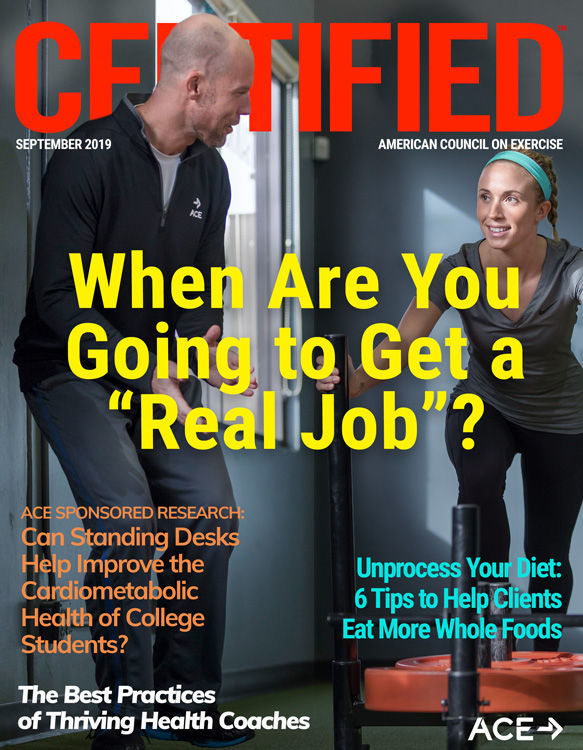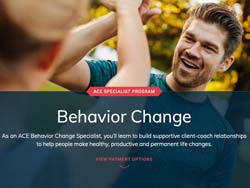
The American College of Sports Medicine’s Worldwide Survey of Fitness Trends for 2019 ranked health and wellness coaching as the 11th most popular trend in the fitness industry. Health and wellness coaching first appeared on the list in 2010 and has gradually increased in popularity, up seven spots from 2018 (Thompson, 2018). With the increased recognition of the value of health coaching, many health and exercise professionals are looking to expand their reach by incorporating coaching strategies into their practices.
The relative newness of health coaching sparks questions for professionals and consumers alike. This article explores some of the most common questions around health coaching and highlights the best practices of successful coaches.
Education
There are numerous workplace settings for health coaches—corporate, medical, commercial and entrepreneurial. As such, the educational requirements vary widely. At minimum, a certification from an NCCA-accredited organization is expected, while a bachelor’s or master’s degree may be required for some positions.
Recently, the National Board for Health and Wellness Coaching (NBHWC) formed, creating the first board certification for health coaching, the National Board Certified Health and Wellness Coach (NBC-HWC) certification, overseen by the National Board of Medical Examiners.
“The National Board for Health and Wellness Coaching was created as a consortium designed to bring all parties together,” explains Jessica Matthews, DBH, assistant professor and director of the Masters of Kinesiology in Integrative Wellness program at Point Loma Nazarene University.
 While an initial accredited certification is vital to becoming a health coach, continuing education is critically important. Chris Sandel, founder and owner of Seven Health, based in Surrey, UK, emphasizes the importance of continuing education. “I originally studied through the College of Naturopathic Medicine and got a diploma in nutrition, but I’ve since done a great deal of continuing education through my own studies and online courses,” says Sandel. He notes that this education spans a variety of fields, including behavior change, motivational interviewing, business and psychology.
While an initial accredited certification is vital to becoming a health coach, continuing education is critically important. Chris Sandel, founder and owner of Seven Health, based in Surrey, UK, emphasizes the importance of continuing education. “I originally studied through the College of Naturopathic Medicine and got a diploma in nutrition, but I’ve since done a great deal of continuing education through my own studies and online courses,” says Sandel. He notes that this education spans a variety of fields, including behavior change, motivational interviewing, business and psychology.
One of the biggest misconceptions about health coaching is the idea that knowledge of nutrition and exercise is enough to promote healthy behavior changes in our clients. While this knowledge is foundational, it is not sufficient. To be a competent and effective health coach, a fundamental understanding of behavior change, motivation and coaching theory is required. Ultimately, the educational requirements for your ideal career will vary depending on the types of clients you serve, but the necessity for foundational and continuing education is a vital component that will propel your career and the industry alike.
The Art and Science of Coaching
Coaching is both a concrete skill and an abstract aptitude. It requires a well-honed toolkit of evidence-based practices and the knowledge of when to employ those tools. A handful of foundational skills make up the backbone of a good health coaching practice.
“The coach approach is essential for empowering the people you work with,” says Matthews. She highlights the actual “being” skills of coaching—a complete presence with and focus on the client—as the foundation of this coach approach. While this may sound simple, it’s not easy. “The best way for coaches to improve is to practice in multiple contexts,” explains Matthews.
Another central tenet of coaching is the idea that clients are in the driver’s seat. This is different from most personal-training settings, in which the client often passively follows the direction of the trainer. Health coaching reverses this paradigm, positioning the client as the director of change.
“I don’t give advice, and I never tell clients what to do,” says Abbi Lichtenstein, MA, NBC-HWC. Rather, she prefers a coaching methodology that involves highlighting clients’ positive attributes and capabilities, while letting them dictate the coaching direction.
“People don’t want to be told what to do, even if they’re paying you to help them,” says Sandel. “There are huge benefits to people coming up with their own ideas and implementing them,” he says. This is often challenging for health coaches who, out of an altruistic desire to help, want to feed their clients answers and solutions. However, behavior-change research suggests that individuals are more likely to implement and stick with new behaviors when they feel autonomous, competent and connected (Ryan and Deci, 2000). By allowing your clients to determine their own goals, priorities and action steps, you foster autonomy. “It doesn’t matter if I’m right if it doesn’t help them change,” says Sandel. “It is far more important to be effective than to be right.”
Creating a client-centered health coaching practice is challenging. Following are a few specific tools you can immediately start using with your clients.
Coaching Toolkit
Powerful Questions
If you want good answers, ask good questions. Powerful and thought-provoking questions can act as a rudder to guide your clients through the tumultuous waters of change. This often involves open-ended questions that cannot be answered with a simple “yes” or “no.” Lichtenstein shares that her use of open-ended questions allows her clients to generate new realizations and perspectives. Open-ended questions invite clients to expand on their thoughts, feelings and beliefs around a particular subject. Powerful questions take open-ended questions a step further in initiating change. These kinds of questions cut to the root of an issue and address things like deep motivations, desired outcomes, deep-seated fears, self-limiting beliefs or possible courses of action. By using powerful questions, you link behavioral changes with intrinsic motivations, fueling the entire change process.
Put it to practice: Get in the habit of asking challenging, thought-provoking questions. Curate a list of powerful questions and then try these questions out with friends, family members or colleagues.
Presence
“To be fully present is to actually, genuinely be with people,” says Matthews, on the power of being present in a coaching session. Being present is a dynamic process that involves a number of other micro skills, such as setting an ideal environment, attuned listening and reflecting. It involves putting the person you are working with at the center of your attention and allowing the session to organically unfold.
 “It’s so important that you really listen to your client and then reflect back what you heard so they know you get them,” urges Lichtenstein. Naturally, whether you see clients in person or virtually, this requires a setting that is conducive to listening; eliminating environmental noise, however, is not sufficient. Often, internal mental chatter can distract us more than external stimuli. In the midst of a coaching session, personal thoughts, self-judgment or ideas might pop up. This is normal but can preclude deep listening. When these distractions arise, you might jot down a quick word or note to ask the client later or simply recognize the distraction and return your focus to your client.
“It’s so important that you really listen to your client and then reflect back what you heard so they know you get them,” urges Lichtenstein. Naturally, whether you see clients in person or virtually, this requires a setting that is conducive to listening; eliminating environmental noise, however, is not sufficient. Often, internal mental chatter can distract us more than external stimuli. In the midst of a coaching session, personal thoughts, self-judgment or ideas might pop up. This is normal but can preclude deep listening. When these distractions arise, you might jot down a quick word or note to ask the client later or simply recognize the distraction and return your focus to your client.
Reflections allow you to connect more deeply with your client and reinforce that you’re paying attention. Reflections can include a summary or paraphrasing of what the client said, a bottom-lining of the main points of a story or double-checking a feeling you are picking up on.
Put it to practice: When trying out your powerful questions with friends or family members, practice deep listening and reflecting. Aim to fully listen to what your counterpart is saying without worrying about what you will say next or how the conversation is going. Affirm that you are listening by reflecting back the person’s sentiments after they finish.
Surrender
As helping professionals, we often envision a specific, desirable outcome for our clients. However, putting too much emphasis on end results hinders the coaching process. While a client may come to you with an intended outcome in mind, such as weight loss or a change in blood biomarkers, the process that brings them there is equally valuable. The coaching relationship is fruitful, not just in its visible yield, but in the learning, experience, awareness and insights that clients develop along the way. Much of the time, these developments are results of what might seem like failed attempts at change.
“It’s not trial and error, it’s trial and learn,” says Taylor Colvey, MA, a health coach in Solana Beach, Calif. “All data that we collect supports change.” The notion of failure as a learning experience is often intuitively simple but challenging for clients to accept. Regularly reaffirming their actions, insights and experiences, regardless of whether or not they adhere to a specified plan, helps clients shift their perspective. Surrendering to the outcome does not, however, disregard a client’s goals and aspirations. “As a coach, I always keep their vision at the forefront of my mind as I assess readiness for change and monitor realistic actions with accountability and support,” Colvey says.
Put it to practice: When learning to surrender to the outcome, turn first to your own life. In what areas have you “failed” or struggled repeatedly over time? Take a closer look—can you identify any insights about your motivations, wants, needs or fears layered into these experiences? Once you find these insights, how can you use them to develop new plans moving forward?
Common Coaching Challenges
Beyond building excellent coaching skills, one of the biggest challenges health coaches face, especially those who operate their own businesses or work as independent contractors, is finding clients. Consumers are often unsure of what a health coach does or how they will benefit from their services.
“My best advice for obtaining clients is to create a ton of content, demonstrating that you know what you’re talking about,” urges Sandel. This process takes time. He recommends creating at least one touch point a week, whether that is a podcast, article, webinar or other form of content. Further, he suggests that coaches find the platform where they have their best voice. For him, podcasting has been the best medium and is how he has gained most of his clients.
Another method of gaining clients is offering free introductory sessions. Lichtenstein and Colvey both offer these sessions to help clients better understand what health coaching is. Colvey offers a free 30-minute session and uses this time to ask clients about their inspirations and what things are getting in the way. Matthews notes that the ambiguity around coaching is often a barrier when looking to obtain clients or jobs. “We must create clarity around who a qualified health coach is and what a health coach really does,” she says.
Beyond the difficulty of acquiring clients, many entrepreneurial coaches struggle with operating their business. As helping professionals, business acumen may not come naturally. Colvey mentions that she reads a great deal of free content from entrepreneurship coaches to help with her business, while Lichtenstein has found partnerships with other organizations, such as health clubs and therapy offices, to be particularly helpful places to house her business.
You might also opt to work with a business coach, which Sandel says has been transformative for his business. “I’ve been working with a business coach for the last year, and that has been huge. It’s really helped me be able to work out where I should be spending my time, how I talk about what I do, the kind of clients I serve,” he says. “Working with a coach has had a significant impact.”
As awareness around health coaching continues to expand, it is vital that coaches are equipped with the skills to effectively guide clients toward lasting change as well as the marketing, business and operational skills to further their own careers.
Continual Evolution
This is an exciting time for the field of health coaching. As the public becomes increasingly aware of what health coaches do and what they have to offer, the opportunities for well-trained and highly skilled coaches will continue to rise. To bring about the best client results and, ultimately, further the field, our coaching skills must grow and advance with the industry.
“The more you study, the more you realize how little you know,” says Sandel. While humbling, this revelation can spur continued education, training and growth in your coaching practice.
As health coaching continues to evolve and expand, new questions, insights and best practices will arise. To stay up-to-date with industry trends, ask your own questions or offer valuable insights, check out ACE’s free Health Coach Network on Facebook. As each of us shares our knowledge and experience, we will further the field of health coaching, allowing us to better serve those who come to us for help.
References
Ryan, R.M. and Deci, E. L. (2000). Self-determination theory and the facilitation of intrinsic motivation, social development, and well-being. American Psychologist, 55, 1, 68–78.
Thompson, W.R. (2018). Worldwide survey of trends for 2019. ACSM’s Health & Fitness Journal, 22, 6, 10.





 by
by 

 While an initial accredited certification is vital to becoming a health coach, continuing education is critically important. Chris Sandel, founder and owner of
While an initial accredited certification is vital to becoming a health coach, continuing education is critically important. Chris Sandel, founder and owner of 





